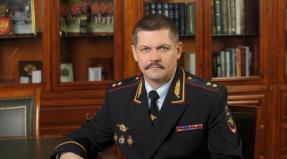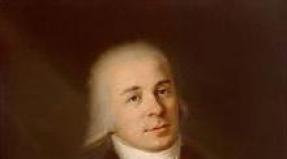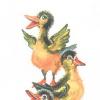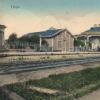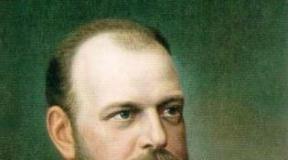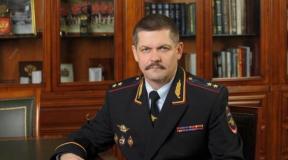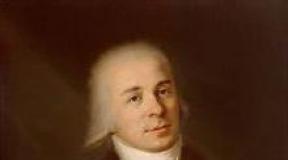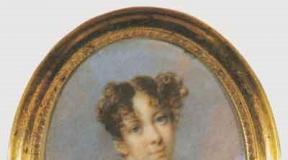Connected with Cyril and Methodius. Creation of the Slavic alphabet by Cyril and Methodius. The significance of the brothers' activities
The creators of the Slavic alphabet are Methodius and Cyril.
At the end of 862, the prince of Great Moravia (the state of the Western Slavs) Rostislav turned to the Byzantine Emperor Michael with a request to send preachers to Moravia who could spread Christianity in the Slavic language (sermons in those parts were read in Latin, unfamiliar and incomprehensible to the people).
Emperor Michael sent the Greeks to Moravia - the scientist Constantine the Philosopher (he received the name Cyril Constantine when he became a monk in 869, and with this name he went down in history) and his older brother Methodius.
The choice was not random. Brothers Constantine and Methodius were born in Thessaloniki (Thessaloniki in Greek) into the family of a military leader and received a good education. Cyril studied in Constantinople at the court of the Byzantine Emperor Michael III, knew Greek, Slavic, Latin, Hebrew, and Arabic well, taught philosophy, for which he received the nickname Philosopher. Methodius was in military service, then for several years he ruled one of the regions inhabited by the Slavs; subsequently retired to a monastery.
In 860, the brothers had already made a trip to the Khazars for missionary and diplomatic purposes.
To be able to preach Christianity in the Slavic language, it was necessary to translate the Holy Scriptures into the Slavic language; however, there was no alphabet capable of conveying Slavic speech at that moment.
 Constantine set about creating the Slavic alphabet. Methodius, who also knew the Slavic language well, helped him in his work, since a lot of Slavs lived in Thessaloniki (the city was considered half-Greek, half-Slavic). In 863, the Slavic alphabet was created (the Slavic alphabet existed in two versions: the Glagolitic alphabet - from verb - “speech” and the Cyrillic alphabet; until now, scientists do not have a consensus which of these two options was created by Cyril). With the help of Methodius, a number of liturgical books were translated from Greek into Slavic. The Slavs were given the opportunity to read and write in their own language. The Slavs not only acquired their own Slavic alphabet, but also the first Slavic literary language was born, many words of which still live in Bulgarian, Russian, Ukrainian and other Slavic languages.
Constantine set about creating the Slavic alphabet. Methodius, who also knew the Slavic language well, helped him in his work, since a lot of Slavs lived in Thessaloniki (the city was considered half-Greek, half-Slavic). In 863, the Slavic alphabet was created (the Slavic alphabet existed in two versions: the Glagolitic alphabet - from verb - “speech” and the Cyrillic alphabet; until now, scientists do not have a consensus which of these two options was created by Cyril). With the help of Methodius, a number of liturgical books were translated from Greek into Slavic. The Slavs were given the opportunity to read and write in their own language. The Slavs not only acquired their own Slavic alphabet, but also the first Slavic literary language was born, many words of which still live in Bulgarian, Russian, Ukrainian and other Slavic languages.
The secret of the Slavic alphabet
The Old Slavic alphabet got its name from the combination of two letters “az” and “buki”, which designated the first letters of the alphabet A and B. An interesting fact is that the Old Slavic alphabet was graffiti, i.e. messages scrawled on the walls. The first Old Slavonic letters appeared on the walls of churches in Pereslavl around the 9th century. And by the 11th century, ancient graffiti appeared in the St. Sophia Cathedral in Kyiv. It was on these walls that the letters of the alphabet were indicated in several styles, and below was the interpretation of the letter-word.
In 1574, a most important event occurred that contributed to a new round of development of Slavic writing. The first printed “ABC” appeared in Lvov, which was seen by Ivan Fedorov, the man who printed it.
ABC structure If you look back, you will see that Cyril and Methodius created not just an alphabet, they opened a new path for the Slavic people, leading to the perfection of man on earth and the triumph of a new faith. If you look at historical events, the difference between which is only 125 years, you will understand that in fact the path to establishing Christianity on our land is directly related to the creation of the Slavic alphabet. After all, literally in one century, the Slavic people eradicated archaic cults and adopted a new faith. The connection between the creation of the Cyrillic alphabet and the adoption of Christianity today does not raise any doubts. The Cyrillic alphabet was created in 863, and already in 988, Prince Vladimir officially announced the introduction of Christianity and the overthrow of primitive cults.
If you look back, you will see that Cyril and Methodius created not just an alphabet, they opened a new path for the Slavic people, leading to the perfection of man on earth and the triumph of a new faith. If you look at historical events, the difference between which is only 125 years, you will understand that in fact the path to establishing Christianity on our land is directly related to the creation of the Slavic alphabet. After all, literally in one century, the Slavic people eradicated archaic cults and adopted a new faith. The connection between the creation of the Cyrillic alphabet and the adoption of Christianity today does not raise any doubts. The Cyrillic alphabet was created in 863, and already in 988, Prince Vladimir officially announced the introduction of Christianity and the overthrow of primitive cults.
Studying the Old Church Slavonic alphabet, many scientists come to the conclusion that in fact the first “ABC” is a secret writing that has a deep religious and philosophical meaning, and most importantly, that it is constructed in such a way that it represents a complex logical-mathematical organism. In addition, by comparing many finds, the researchers came to the conclusion that the first Slavic alphabet was created as a complete invention, and not as a creation that was created in parts by adding new letter forms. It is also interesting that most of the letters of the Old Church Slavonic alphabet are number letters. Moreover, if you look at the entire alphabet, you will see that it can be conditionally divided into two parts, which are fundamentally different from each other. In this case, we will conditionally call the first half of the alphabet the “higher” part, and the second “lower”. The highest part includes the letters from A to F, i.e. from “az” to “fert” and is a list of letter-words that carry a meaning understandable to a Slav. The lower part of the alphabet begins with the letter “sha” and ends with “izhitsa”. The letters of the lower part of the Old Church Slavonic alphabet do not have a numerical value, unlike the letters of the higher part, and carry a negative connotation.
In order to understand the secret writing of the Slavic alphabet, it is necessary not just to skim through it, but to read carefully into each letter-word. After all, each letter-word contains a semantic core that Konstantin put into it.
Literal truth, the highest part of the alphabet Az is the initial letter of the Slavic alphabet, which denotes the pronoun Ya. However, its root meaning is the word “initially”, “begin” or “beginning”, although in everyday life the Slavs most often used Az in the context of a pronoun. Nevertheless, in some Old Slavonic letters one can find Az, which meant “one”, for example, “I will go to Vladimir”. Or “starting from scratch” meant “starting from the beginning.” Thus, the Slavs denoted with the beginning of the alphabet the entire philosophical meaning of existence, where without beginning there is no end, without darkness there is no light, and without good there is no evil. At the same time, the main emphasis in this is placed on the duality of the structure of the world. Actually, the alphabet itself is built on the principle of duality, where it is conventionally divided into two parts: higher and lower, positive and negative, the part located at the beginning and the part that is at the end. In addition, do not forget that Az has a numerical value, which is expressed by the number 1. Among the ancient Slavs, the number 1 was the beginning of everything beautiful. Today, studying Slavic numerology, we can say that the Slavs, like other peoples, divided all numbers into even and odd. Moreover, odd numbers were the embodiment of everything positive, good and bright. Even numbers, in turn, represented darkness and evil. Moreover, the unit was considered the beginning of all beginnings and was highly revered by the Slavic tribes. From the point of view of erotic numerology, it is believed that 1 represents the phallic symbol from which procreation begins. This number has several synonyms: 1 is one, 1 is one, 1 is times.
Az is the initial letter of the Slavic alphabet, which denotes the pronoun Ya. However, its root meaning is the word “initially”, “begin” or “beginning”, although in everyday life the Slavs most often used Az in the context of a pronoun. Nevertheless, in some Old Slavonic letters one can find Az, which meant “one”, for example, “I will go to Vladimir”. Or “starting from scratch” meant “starting from the beginning.” Thus, the Slavs denoted with the beginning of the alphabet the entire philosophical meaning of existence, where without beginning there is no end, without darkness there is no light, and without good there is no evil. At the same time, the main emphasis in this is placed on the duality of the structure of the world. Actually, the alphabet itself is built on the principle of duality, where it is conventionally divided into two parts: higher and lower, positive and negative, the part located at the beginning and the part that is at the end. In addition, do not forget that Az has a numerical value, which is expressed by the number 1. Among the ancient Slavs, the number 1 was the beginning of everything beautiful. Today, studying Slavic numerology, we can say that the Slavs, like other peoples, divided all numbers into even and odd. Moreover, odd numbers were the embodiment of everything positive, good and bright. Even numbers, in turn, represented darkness and evil. Moreover, the unit was considered the beginning of all beginnings and was highly revered by the Slavic tribes. From the point of view of erotic numerology, it is believed that 1 represents the phallic symbol from which procreation begins. This number has several synonyms: 1 is one, 1 is one, 1 is times.
 Beeches(Beech) is the second letter-word in the alphabet. It has no numerical meaning, but has no less deep philosophical meaning than Az. Buki means “to be”, “will be” was most often used when using phrases in the future form. For example, “boudi” means “let it be,” and “boudous,” as you probably already guessed, means “future, upcoming.” In this word, our ancestors expressed the future as an inevitability, which could be either good and rosy or gloomy and terrible. It is still not known for certain why Constantine did not give a numerical value to Bukam, but many scientists suggest that this is due to the duality of this letter. Indeed, by and large, it denotes the future, which every person imagines for himself in a rosy light, but on the other hand, this word also denotes the inevitability of punishment for committed low deeds.
Beeches(Beech) is the second letter-word in the alphabet. It has no numerical meaning, but has no less deep philosophical meaning than Az. Buki means “to be”, “will be” was most often used when using phrases in the future form. For example, “boudi” means “let it be,” and “boudous,” as you probably already guessed, means “future, upcoming.” In this word, our ancestors expressed the future as an inevitability, which could be either good and rosy or gloomy and terrible. It is still not known for certain why Constantine did not give a numerical value to Bukam, but many scientists suggest that this is due to the duality of this letter. Indeed, by and large, it denotes the future, which every person imagines for himself in a rosy light, but on the other hand, this word also denotes the inevitability of punishment for committed low deeds.
 Lead- an interesting letter of the Old Church Slavonic alphabet, which has a numerical value of 2. This letter has several meanings: to know, to know and to own. When Constantine put this meaning into the Vedi, he meant secret knowledge, knowledge as the highest divine gift. If you put Az, Buki and Vedi into one phrase, you will get a phrase that means “I will know!”. Thus, Constantine showed that a person who discovered the alphabet he created would subsequently possess some kind of knowledge. The numerical load of this letter is no less important. After all, 2 - deuce, two, pair were not just numbers among the Slavs, they took an active part in magical rituals and in general were symbols of the duality of everything earthly and heavenly. The number 2 among the Slavs meant the unity of heaven and earth, the duality of human nature, good and evil, etc. In a word, the deuce was a symbol of the confrontation between two sides, heavenly and earthly balance. Moreover, it is worth noting that the Slavs considered two to be a devilish number and attributed a lot of negative properties to it, believing that it was two that opened the numerical series of negative numbers that bring death to a person. That is why the birth of twins in Old Slavonic families was considered a bad sign, which brought illness and misfortune to the family. In addition, the Slavs considered it a bad sign for two people to rock a cradle, for two people to dry themselves with the same towel, and generally to perform any action together. Despite such a negative attitude towards the number 2, the Slavs recognized its magical power. For example, many exorcism rituals were performed using two identical objects or with the participation of twins.
Lead- an interesting letter of the Old Church Slavonic alphabet, which has a numerical value of 2. This letter has several meanings: to know, to know and to own. When Constantine put this meaning into the Vedi, he meant secret knowledge, knowledge as the highest divine gift. If you put Az, Buki and Vedi into one phrase, you will get a phrase that means “I will know!”. Thus, Constantine showed that a person who discovered the alphabet he created would subsequently possess some kind of knowledge. The numerical load of this letter is no less important. After all, 2 - deuce, two, pair were not just numbers among the Slavs, they took an active part in magical rituals and in general were symbols of the duality of everything earthly and heavenly. The number 2 among the Slavs meant the unity of heaven and earth, the duality of human nature, good and evil, etc. In a word, the deuce was a symbol of the confrontation between two sides, heavenly and earthly balance. Moreover, it is worth noting that the Slavs considered two to be a devilish number and attributed a lot of negative properties to it, believing that it was two that opened the numerical series of negative numbers that bring death to a person. That is why the birth of twins in Old Slavonic families was considered a bad sign, which brought illness and misfortune to the family. In addition, the Slavs considered it a bad sign for two people to rock a cradle, for two people to dry themselves with the same towel, and generally to perform any action together. Despite such a negative attitude towards the number 2, the Slavs recognized its magical power. For example, many exorcism rituals were performed using two identical objects or with the participation of twins.
Having examined the highest part of the alphabet, we can state the fact that it is Constantine’s secret message to his descendants. “Where is this visible?” - you ask. Now try to read all the letters, knowing their true meaning. If you take several subsequent letters, then edifying phrases are formed:
Vedi + Verb means “know the teaching”;
Rtsy + Word + Firmly can be understood as the phrase “speak the true word”;
Firmly + Oak can be interpreted as “strengthen the law.”
If you look closely at other letters, you can also find the secret writing that Constantine the Philosopher left behind.
Have you ever wondered why the letters in the alphabet are in this particular order and not in any other? The order of the “highest” part of the Cyrillic letters can be considered from two positions.
Firstly, the fact that each letter-word forms a meaningful phrase with the next one may mean a non-random pattern that was invented to quickly memorize the alphabet.
Secondly, the Old Church Slavonic alphabet can be considered from the point of view of numbering. That is, each letter also represents a number. Moreover, all letter-numbers are arranged in ascending order. So, the letter A - “az” corresponds to one, B - 2, D - 3, D - 4, E - 5, and so on up to ten. Tens begin with the letter K, which are listed here similarly to units: 10, 20, 30, 40, 50, 70, 80 and 100.
In addition, many scientists have noticed that the outlines of the letters of the “higher” part of the alphabet are graphically simple, beautiful and convenient. They were perfect for cursive writing, and a person did not experience any difficulties in depicting these letters. And many philosophers see in the numerical arrangement of the alphabet the principle of the triad and spiritual harmony that a person achieves, striving for good, light and truth.
Having studied the alphabet from the very beginning, we can come to the conclusion that Constantine left his descendants the main value - a creation that encourages us to strive for self-improvement, learning, wisdom and love, remembering the dark paths of anger, envy and enmity.
 Now, revealing the alphabet, you will know that the creation that was born thanks to the efforts of Constantine the Philosopher is not just a list of letters with which words begin that express our fear and indignation, love and tenderness, respect and delight.
Now, revealing the alphabet, you will know that the creation that was born thanks to the efforts of Constantine the Philosopher is not just a list of letters with which words begin that express our fear and indignation, love and tenderness, respect and delight.
1901 publications dedicated to Cyril and Methodius were published only in the first 30 post-war years. The total number of books and articles telling about the creators of Slavic writing can hardly be counted.
The fashion for everything connected with the Slavic first teachers is gaining momentum, and it seems that it has always been this way. Meanwhile, several centuries after the death of Cyril and Methodius, the memory of them began to fade. And in the 17th century, their names were completely crossed out from the church calendar. They were remembered only in the 19th century, when the Slavic peoples living on the territory of the Ottoman Empire and Austria-Hungary began the struggle for independence. It was then that the names of Cyril and Methodius became a symbol of the Slavic revival.
The creators of something there
Once upon a time, at the very beginning of perestroika, on the day of church memory of Cyril and Methodius, a holiday of writing began to be held. It was unusual and interesting. The topic still seemed semi-forbidden, and conferences and lectures dedicated to this day were held in front of full houses. But the novelty soon wore off, and the celebration turned into officialdom, called the “Day of Slavic Literature and Culture.” One more has been added to the series of holidays inherited from Soviet life that fall on warm May. Moreover, during the folk festivals, concerts and dances, the essence of the holiday was somehow lost.
The true history of Cyril and Methodius is too complex and confusing, so they prefer not to go into details of their biographies, limiting themselves to general words about what the brothers did for the Slavs. Don’t give vacationers a lecture that could distract them from the barbecue and the Ferris wheel. We created writing, now we can celebrate.
Meanwhile, the history of the creation of Slavic writing is like a fascinating detective story, and it is a pity that the holiday, conceived as an educational one, turned into an entertainment show. Well, it would be possible to at least explain why we call Cyril the creator of Slavic writing, if he created not the Cyrillic alphabet, which we use to this day, but another alphabet - the Glagolitic alphabet.
The fact is that the creation of writing is only the very last step of composing specific graphic signs. What Kirill really did was to identify semantic elements in the language and correlate them with the symbols he invented. This is what is called the creation of writing.
Books written in Glagolitic alphabet, which was created by Konstantin-Kirill, looked like this
And it’s not at all difficult to create icons, declaring that the letter “a” will now look like a dollar sign, “b” like a circle, and “c” like a man with a flag in his hand. What child, having read Conan Doyle's story about the dancing men, has not tried to do something similar? But what he ends up with is a rudimentary cipher based on an already existing writing system.
When, a century after the death of Cyril, the exotic Glagolitic alphabet was replaced by the Cyrillic alphabet, reproducing a simple pattern of Greek letters, this replacement no longer required the colossal labor that was necessary to create a new writing system.

The letters of the Glagolitic alphabet are not similar to the letters of other alphabets. For two centuries now there have been completely fruitless debates about what Cyril was looking at when he composed these strange signs. Some letters seem to be borrowed from Hebrew writing, some from Greek cursive writing, but for most of the characters there are no explanations. The explanation seems quite reasonable that this is a specially invented alphabet, and not a successful experience in adapting an already existing alphabet for another language.
Kirill created his system following some principle that is not particularly clear to us. Most Glagolitic letters can be represented as a combination of three elements - a cross, a triangle and a circle. And here we get scope for various symbolic fantasies. The cross stands for Christ, the circle for infinity, the triangle for the Trinity. “Az” - the first letter of the alphabet - has the shape of a cross, which is hardly accidental.
It is obvious that the remaining letters, according to the creator’s plan, represented some kind of symbolic system. There have been many attempts to decipher it. But, alas, puzzles of this kind, as a rule, do not have solutions. We have no criteria for testing hypotheses, and reasoning very quickly takes on the character of unprovable fantasies. What is certain is that the creator of the Glagolitic alphabet tried to construct the external appearance of the letters in accordance with some internal logic, which we cannot restore. Although I really want to.
Biographer and hagiographer
We are told about Cyril and Methodius by their lives, created a considerable time after their death. Reading these lives is a fascinating experience. Here are records of theological disputes, stories about diplomatic travels, intrigues of the Byzantine court, and much more. But it’s very difficult to turn a hagiographic narrative into a biographical story in which ends meet.
According to the lives, the younger brother Constantine (he received the name Cyril after accepting the schema before his death) was born around 827, and Methodius, the eldest, in 815. They were the children of a Byzantine official who gave his children an excellent education. Among Constantine's teachers were the future Patriarch of Constantinople Photius and the outstanding scientist of that time Leo the Mathematician.
The talented young man had a brilliant career ahead of him, but he chose monasticism, left the capital and settled in one of the monasteries of Asia Minor. But he was unable to completely escape the life of the capital. And soon the young monk returned to Constantinople, where he began teaching philosophy. But then the confusion begins.
The Life tells, for example, that the young theologian defeated the iconoclast patriarch John the Grammar, a brilliant orator and the last of the authoritative opponents of icon veneration, during a public debate. However, it is very difficult to believe that everything happened exactly as life describes it. The fact is that by the time Constantine returned to the capital, iconoclasm had already been condemned and public discussions made no sense.
Of course, various explanations can be invented for such contradictions. One can, for example, assume that Constantine wrote a treatise directed against the iconoclasts, compiled in the form of a dialogue with John the Grammar, and later the author of the life included this treatise in his text, turning it into a fact of the biography of Constantine. Other explanations are possible, but they all remain hypotheses.
It is even more difficult to tell clearly about the missionary journeys that Constantine made. The life tells how he preached among Muslims and Jews, as a result of which his listeners accepted Christianity. However, we have no other evidence of mass baptisms of Muslims and Jews dating back to that time. Therefore, the life story raises doubts. There is no doubt that Constantine really went to the capital of the Arab Caliphate and to the Khazars. But the purpose of this trip was most likely not missionary, but diplomatic. He could, for example, accompany some embassies during negotiations on the exchange of prisoners.
Similar problems almost always arise when historians try to extract biographical information from the lives of saints. Lives are not intended for this. The authors of lives are called hagiographers (ἅγιος - “saint”; γράφω - “I write”), that is, they, unlike biographers (βίος - “life”, γράφω - “I write”), write not the history of life, but the history of holiness. The historian is interested precisely in biographical information, which ends up in lives only through oversight. We have to be content with these crumbs, since we have no other sources of information about the creators of Slavic writing.
“Send us, Vladyka, such a bishop and teacher...”
But actually, why did Constantine and Methodius need to create a special writing system for the Slavs? The Middle Ages treated the idea of translating divine services into the languages of newly baptized barbarian peoples without much enthusiasm. The situation when all national communities prayed in Greek or Latin gave Constantinople and Rome the opportunity to at least somehow control the activities of distant outskirts. The transition to national languages, incomprehensible to the residents of the capitals, as it seemed to many, threatened chaos.
The priests could preach as much as they wanted in the local language, but the language of writing, culture and correspondence with the authorities had to remain Greek and Latin. In addition, among the imperial nobility, the idea, dating back to antiquity, was preserved that there were only two languages on earth - their own and the barbarian. Therefore, neither Rome nor Constantinople set themselves the task of giving writing to those peoples who were under their subordination.
According to the life of Constantine-Cyril, in 862 the Moravian prince Rostislav sent a letter to Emperor Michael that said:
“Although our people have rejected paganism and adhere to the Christian law, we do not have such a teacher who could explain to us the right Christian faith in our language... So send us, Vladyka, a bishop and such a teacher.”
The modern reader in this letter, of course, is struck by the request to send a teacher, but Rostislav first of all wanted a bishop, which would mean Moravia gaining church independence. And it was precisely this request that Constantinople ignored, sending not a bishop, but people who had no status in the church hierarchy. Two brothers went to Moravia - monk Constantine and hieromonk Methodius.
Neither Emperor Michael nor Patriarch Photius thought about giving the Slavs writing. If Constantine and Methodius had been sent to Moravia to preach and translate divine services into the Slavic language, then their mission should have been considered brilliantly accomplished. Meanwhile, for some reason this mission is not mentioned in Byzantine sources. So, apparently, the creation of writing was a personal project of Constantine. Before setting off, he, according to his life, figured out how to write down the language of the Slavs, created an alphabet and prepared the first translations.

Constantine and Methodius were Greeks, but it is believed that one of the Slavic dialects was familiar to them from childhood. In Soluni (Thessaloniki), where they were from, many Slavs lived. They spoke a dialect that was somewhat different from the dialect of the Moravians. This means that the language into which Constantine translated the liturgical texts was understandable to the Moravians, but did not in every way coincide with their everyday language.

A historical accident determined a very important feature of the writing created by Cyril. In all Slavic countries, the book language was quite close to the spoken language, but still differed somewhat from it. And this happened everywhere. From Moravia, Slavic writing came to Bulgaria, that is, to the southern Slavs, then to Kievan Rus to the Eastern Slavs. It was a common Slavic book and liturgical language, on the one hand, relatively understandable, and on the other, different from each specific dialect and dialect.
Diplomatic miracle
To introduce worship in the Slavic language, translations alone were not enough. It was necessary to prepare priests capable of serving using these translations. Also needed were scribes preparing copies of Slavic books. And except for two brothers who came from Constantinople, no one knew this writing. However, Constantine and Methodius turned out to be excellent organizers. They managed to quickly gather around them a circle of students and followers who were passionate about the idea of Slavic writing and worship in the Slavic language.
But there was one subtlety here. Such a project is impossible to implement without serious administrative resources, which our missionaries clearly did not possess. It was possible to teach local youth how to use Slavic books as much as one wanted, but neither Constantine, who was a simple monk, nor Methodius could ordain their students as priests. For this, a bishop was needed, but the missionary brothers did not have a good relationship with the local episcopate.
The Moravian clergy was quite traditional and believed that translations were superfluous, and it was necessary to serve in the language in which they had always served in Moravia, that is, in Latin. The local episcopate shared this belief, so any attempts to introduce translations into church practice were paralyzed. Some kind of non-standard solution was required, and the missionary brothers found it.
Moravia was ecclesiastically subordinate to Rome, so Constantine and Methodius went to seek support there. Despite the difficult relations between Constantinople and Rome, the final division of the church into Orthodox and Catholic had not yet occurred, so Byzantine monks could go to Rome completely freely. Although it seemed that there was nothing to hope for there either. Rome, which advocates the centralization of church life, never abandoned Latin and did not approve worship in local languages. But Constantine and Methodius had a trump card hidden.
A few years before his trip to Moravia, Constantine ended up in Chersonesus (now a region of Sevastopol), where in the 1st century AD. e. Clement, the fourth pope, was exiled. Cyril managed to discover the relics of St. Clement, take them to Constantinople, and then take them with him to Moravia.

The relics of one of the first popes were a most precious relic for Rome, and the person who brought this jewel directly to the papal palace acquired unlimited possibilities.
Lives tell that the liturgical books translated by Constantine and Methodius not only received the approval of the pope, but they were used for services in several Roman churches. The pope ordained the young people who came with their brothers to Rome to the priesthood, and made Methodius a bishop, giving him the right to independently ordain his students. Slavic translations thus acquired legal status.

True, Constantine himself no longer had time to reap the benefits of his diplomatic victory. In Rome he fell ill and, having adopted the schema and name Cyril before his death, he died and was buried in the Basilica of St. Clement, whose relics the brothers brought to Rome.
A defeat that became a victory
Ordained a bishop, Methodius returned with his disciples to Moravia and for 16 years legally continued the activities that they had begun together with Cyril. During this time, he and his students translated the Bible and other church books into Slavic. And the training of experts in Slavic literacy was put on stream. According to his life, Methodius prepared 200 priests who could serve in the Slavic language.
But opponents of worship in national languages stood their ground, and even the patronage of the Pope did not save Methodius from charges of heresy and imprisonment. However, he still managed to get free, go to Rome again and completely justify himself. His rank and authority made it possible to protect Slavic worship from prohibition. But everything rested only on him.
A year after the death of Methodius, Slavic writing was banned in Moravia, and members of the Methodius circle were, at best, expelled from the country, and at worst, sold into slavery. The center of Slavic writing created by Cyril and Methodius was destroyed, and it seemed that their educational project ceased to exist. But everything turned out differently.
Experts in Slavic writing expelled from Moravia were readily accepted in neighboring Bulgaria. Some fled there from persecution, and some were even found in Venice at the slave market and ransomed. The attention that the Bulgarian Tsar Boris paid to Methodius’ students was not an accident.
Bulgaria's relations with Byzantium were difficult, and Boris sought some cultural isolation of his country. A step towards such isolation was supposed to be language reform, that is, the transition of worship and state office work from Greek to Slavic.
The reform was prepared in deep secrecy. The specialists who moved from Moravia were hidden from prying eyes away from the capital. Centers were created in the outback where books were copied, new translations were carried out and personnel were trained. One of these centers was located on the shores of Lake Ohrid, the other in Preslav.
It is believed that it was in the process of preparing the Bulgarian language reform that the Glagolitic alphabet was replaced by the Cyrillic alphabet. Cyrillic letters, reproducing the Greek statutory letter, seemed more acceptable to the Bulgarians than the unlikeable Glagolitic alphabet.
In 893, the secret period of preparation for the reform was completed, and the Bulgarian Tsar Simeon, son of Boris, convened a council at which the Slavic language was declared the language of church and state. The private project of Cyril and Methodius thus acquired state status. As a matter of fact, from this moment the widespread dissemination of Slavic writing began.
Slavic books came to Rus' in connection with the preaching of Christianity. We find the first mention of the fact that Slavic literacy began to be taught in Rus' in “The Tale of Bygone Years,” which says that immediately after the official baptism of Rus', Vladimir gathered the children of the Kyiv nobility (“deliberate children”) and set them to reading books. And the chronicler associates the appearance of the first translation center and scriptorium with his successor Yaroslav.
“And Yaroslav loved church charters,” the chronicle reports in 1036, “he loved a lot of priests, especially the monks, and he loved books, reading them often both night and day. And he gathered many scribes, and they translated from Greek into Slavic. And they wrote many books, from which believers learn and enjoy divine teaching.”
“The Poles hate the Russians, the Czechs don’t get along with the Moravans, the Croats are jealous of the Serbs, the Bosniaks are alienated from the Bulgarians...”
After the lands of the southern Slavs were conquered by the Turks, Rus' became the main center of Slavic writing. For the inhabitants of Rus', writing was associated more with Prince Vladimir, who baptized Rus', than with Cyril and Methodius. They began to be forgotten. And in the 17th century, when Patriarch Nikon corrected the liturgical books, the names of the creators of the Slavic alphabet were completely crossed out from the church calendar.
The Bulgarians fighting for independence remembered Cyril and Methodius again. The first Cyril and Methodius celebrations took place in 1858 in Plovdiv. This was perceived as a challenge. The Patriarchate of Constantinople, to which the Bulgarian Church belonged, was strongly opposed. The official reason for discontent was that this event had not only a church, but also a political component, and they did not want to provoke a big scandal. However, the celebrations took place and a precedent emerged. The example turned out to be contagious.
In 1862, Moravian Slavic Catholics living in the territory of Austria-Hungary began to prepare for the celebration of the 1000th anniversary of the Moravian mission of Cyril and Methodius. The Russian church press of those years wrote with poorly concealed envy that Catholics and Protestants remembered the creators of Slavic writing, but Orthodox Christians did not.
The magazine “Spiritual Conversation” wrote:
“In the current year, which is named by the Roman Church as the year of the Slavic jubilee, it is appointed in all churches, both Roman Catholic and Lutheran, to read special prayers and sing special hymns in honor of the Slavic enlighteners at all services.”
This was a veiled call to fellow believers to remember that they have the most direct connection to this anniversary.
As a result, Russia also joined the festive events. Publicists finally noticed that the names of Cyril and Methodius were missing from the liturgical books. The Synod decided not only to return their names to the church calendar, but also to urgently prepare and print liturgical texts dedicated to these saints. And two years after these celebrations, the historian Mikhail Pogodin published the “Cyril and Methodius Collection,” which became the manifesto of the Slavophile movement.

The Church Remembrance Day of Cyril and Methodius turned into a state holiday “Day of Slavic Literature and Culture”
Pogodin himself placed here his “District Letter to the Slavs,” in which he complained about the mutual hostility of the Slavic peoples (“the Poles hate the Russians, the Czechs do not get along with the Moravans, the Croats are jealous of the Serbs, the Bosniaks are alienated from the Bulgarians”) and suggested that the Russians take on the unifying function. Pogodin saw the basis for such a unification in language. The idea that linguistic unity should form the basis of political unity ran through many of the articles in this collection.
Slavophile ideas and public interest in the struggle of the Slavic peoples for independence stimulated a revival of interest in Cyril and Methodius, associated with the struggle of the Slavic peoples for independence and the ideas of Slavic unity. Gradually, stories about the Thessaloniki brothers were included in popular books and primers, and services dedicated to them were included in liturgical books.

The October Revolution changed the system of values and guidelines. National festivals dedicated to the creators of writing were no longer held. They were modestly mentioned as great educators, but no details were touched upon.
After World War II, when all Slavic countries turned out to be socialist, Slavic reciprocity again became relevant. And in post-Soviet times, Cyril and Methodius entered the mass consciousness in the format of a large public holiday with speeches and orchestras.
Cyril and Methodius - creators of the Russian alphabet
What was the feat of Cyril and Methodius?
The goal of the project: to introduce students to the books of the Holy Scriptures translated by the holy Equal-to-the-Apostles brothers Cyril and Methodius. Reveal the activities of Cyril and Methodius in creating the Slavic alphabet (Cyrillic alphabet)
Hypothesis Cyril and Methodius were the first educators of the Slavic people.
Project objectives To get acquainted with the life and educational activities of Cyril and Methodius. Study the first Slavic alphabets (Cyrillic and Glagolitic) Make a comparative analysis of them Find information about the holiday Day of Slavic Writing
Progress of the research Setting a hypothesis Setting goals and objectives Studying theoretical material from various sources. Comparison of the first two alphabets: Cyrillic and Glagolitic. Selecting the necessary material to create a presentation. Creating a presentation
“In the beginning was the word...” Cyril and Methodius, Slavic educators, creators of the Slavic alphabet, preachers of Christianity, the first translators of liturgical books from Greek into Slavic. Cyril (before taking monasticism in 869 - Constantine) (827 - 02/14/869) and his older brother Methodius (815 - 04/06/885) were born in the city of Thessaloniki in the family of a military leader. The boys' mother was Greek, and their father was Bulgarian, so from childhood they had two native languages - Greek and Slavic. The brothers' characters were very similar. Both read a lot and loved to study.
Holy brothers Cyril and Methodius, educators of the Slavs. In 863-866, the brothers were sent to Great Moravia to present Christian teachings in a language understandable to the Slavs. Great teachers translated the books of the Holy Scriptures, using Eastern Bulgarian dialects as the basis, and created a special alphabet - the Glagolitic alphabet - for their texts. The activities of Cyril and Methodius had a pan-Slavic significance and influenced the formation of many Slavic literary languages.
Saint Equal to the Apostles Cyril (827 - 869), nicknamed the Philosopher, Slovenian teacher. When Konstantin was 7 years old, he had a prophetic dream: “My father gathered all the beautiful girls of Thessaloniki and ordered one of them to be chosen as his wife. Having examined everyone, Konstantin chose the most beautiful; her name was Sophia (Greek for wisdom).” So, even in childhood, he became engaged to wisdom: for him, knowledge and books became the meaning of his whole life. Constantine received an excellent education at the imperial court in the capital of Byzantium - Constantinople. He quickly studied grammar, arithmetic, geometry, astronomy, music, and knew 22 languages. Interest in science, perseverance in learning, hard work - all this made him one of the most educated people of Byzantium. It is no coincidence that he was nicknamed the Philosopher for his great wisdom. Saint Equal to the Apostles Cyril
Methodius of Moravia Saint Methodius Equal to the Apostles Methodius entered military service early. For 10 years he was the manager of one of the regions inhabited by the Slavs. Around 852, he took monastic vows, renouncing the rank of archbishop, and became abbot of the monastery. Polychron on the Asian shore of the Sea of Marmara. In Moravia he was imprisoned for two and a half years and dragged through the snow in the bitter cold. The Enlightener did not renounce his service to the Slavs, but in 874 he was released by John VIII and restored to his episcopate rights. Pope John VIII forbade Methodius to perform the Liturgy in the Slavic language, but Methodius, visiting Rome in 880, achieved the lifting of the ban. In 882-884 he lived in Byzantium. In mid-884, Methodius returned to Moravia and worked on translating the Bible into Slavic.
Glagolitic is one of the first (along with Cyrillic) Slavic alphabets. It is assumed that it was the Glagolitic alphabet that was created by the Slavic enlightener St. Konstantin (Kirill) Philosopher for recording church texts in the Slavic language. Glagolitic
The Old Church Slavonic alphabet was compiled by the scientist Cyril and his brother Methodius at the request of the Moravian princes. That's what it's called - Cyrillic. This is the Slavic alphabet, it has 43 letters (19 vowels). Each has its own name, similar to ordinary words: A - az, B - beeches, V - lead, G - verb, D - good, F - live, Z - earth and so on. ABC - the name itself is derived from the names of the first two letters. In Rus', the Cyrillic alphabet became widespread after the adoption of Christianity (988). The Slavic alphabet turned out to be perfectly adapted to accurately convey the sounds of the Old Russian language. This alphabet is the basis of our alphabet. Cyrillic
IV page “Revival of the Slavic holiday” Macedonia Ohrid Monument to Cyril and Methodius Already in the 9th – 10th centuries, the first traditions of glorifying and venerating the creators of Slavic writing began to emerge in the homeland of Cyril and Methodius. But soon the Roman Church began to oppose the Slavic language, calling it barbaric. Despite this, the names of Cyril and Methodius continued to live among the Slavic people, and in the middle of the 14th century they were officially canonized as saints. In Russia it was different. The memory of the Slavic enlighteners was celebrated already in the 11th century; here they were never considered heretics, that is, atheists. But still, only scientists were more interested in this. Wide celebrations of the Slavic word began in Russia in the early 60s of the last century.
Monument to Saints Cyril and Methodius The holiday in honor of Cyril and Methodius is a public holiday in Russia (since 1991), Bulgaria, the Czech Republic, Slovakia and the Republic of Macedonia. In Russia, Bulgaria and the Republic of Macedonia the holiday is celebrated on May 24; in Russia and Bulgaria it is called the Day of Slavic Culture and Literature, in Macedonia - the Day of Saints Cyril and Methodius. In the Czech Republic and Slovakia the holiday is celebrated on July 5th.
The Days of Slavic Literature are the only church and state holiday in Russia. It received official status in January 1991. Every year on spring days, days of Slavic writing and culture are celebrated throughout the country so that people do not forget that Cyril and Methodius helped preserve the language and culture of the Slavs through letters and writing. Its main goal is the unity of people united by one Slavic culture, the formation of patriotic and civic qualities of the individual, the education of spirituality and morality, the stabilization and harmonization of social, interethnic and interreligious relations.
http://ru.wikipedia.org/wiki www.b-port.com/…/archive/ http://images.yandex.ru http://guru.sevstar.net http://raduga.lekks.ru http://fotki.yandex.ru http://susanin.udm.ru http://www.mion.novsu.ac.ru http://venividi.ru http://chekushka3.narod.ru/fotomukachevo. html Resources YaODB im. I.A. Krylova. Methodological department. Alive as life. Digest. To help work on the Russian language with children and teenagers. In two parts. Part II. – Yaroslavl, 2005 http://office.microsoft.com
Thank you for your attention!
On May 24, the Russian Orthodox Church celebrates the memory of Saints Equal-to-the-Apostles Cyril and Methodius.
The name of these saints is known to everyone from school, and it is to them that all of us, native speakers of the Russian language, owe our language, culture, and writing.
Incredibly, all European science and culture were born within the monastery walls: it was at the monasteries that the first schools were opened, children were taught to read and write, and extensive libraries were collected. It was for the enlightenment of peoples, for the translation of the Gospel, that many written languages were created. This happened with the Slavic language.
The holy brothers Cyril and Methodius came from a noble and pious family who lived in the Greek city of Thessaloniki. Methodius was a warrior and ruled the Bulgarian principality of the Byzantine Empire. This gave him the opportunity to learn the Slavic language.
Soon, however, he decided to leave the secular lifestyle and became a monk at the monastery on Mount Olympus. From childhood, Constantine showed amazing abilities and received an excellent education together with the young Emperor Michael 3rd at the royal court.
Then he became a monk in one of the monasteries on Mount Olympus in Asia Minor.
His brother Constantine, who took the name Cyril as a monk, was distinguished by great abilities from an early age and perfectly comprehended all the sciences of his time and many languages.
Soon the emperor sent both brothers to the Khazars to preach the gospel. As the legend says, along the way they stopped in Korsun, where Constantine found the Gospel and the Psalter written in “Russian letters,” and a man speaking Russian, and began to learn to read and speak this language.
When the brothers returned to Constantinople, the emperor again sent them on an educational mission - this time to Moravia. The Moravian prince Rostislav was oppressed by the German bishops, and he asked the emperor to send teachers who could preach in the native language of the Slavs.
The first of the Slavic peoples to turn to Christianity were the Bulgarians. The sister of the Bulgarian prince Bogoris (Boris) was held hostage in Constantinople. She was baptized with the name Theodora and was raised in the spirit of the holy faith. Around 860, she returned to Bulgaria and began to persuade her brother to accept Christianity. Boris was baptized, taking the name Mikhail. Saints Cyril and Methodius were in this country and with their preaching they greatly contributed to the establishment of Christianity in it. From Bulgaria, the Christian faith spread to its neighboring Serbia.
To fulfill the new mission, Constantine and Methodius compiled the Slavic alphabet and translated the main liturgical books (Gospel, Apostle, Psalter) into Slavic. This happened in 863.
In Moravia, the brothers were received with great honor and began to teach Divine services in the Slavic language. This aroused the anger of the German bishops, who performed divine services in Latin in the Moravian churches, and they filed a complaint to Rome.
Taking with them the relics of Saint Clement (Pope), which they discovered back in Korsun, Constantine and Methodius went to Rome.
Having learned that the brothers were carrying holy relics with them, Pope Adrian greeted them with honor and approved the service in the Slavic language. He ordered the books translated by the brothers to be placed in Roman churches and the liturgy to be performed in the Slavic language.
Saint Methodius fulfilled his brother’s will: returning to Moravia already in the rank of archbishop, he worked here for 15 years. From Moravia, Christianity penetrated into Bohemia during the lifetime of Saint Methodius. The Bohemian prince Borivoj received holy baptism from him. His example was followed by his wife Lyudmila (who later became a martyr) and many others. In the mid-10th century, the Polish prince Mieczyslaw married the Bohemian princess Dabrowka, after which he and his subjects accepted the Christian faith.
Subsequently, these Slavic peoples, through the efforts of Latin preachers and German emperors, were torn away from the Greek Church under the rule of the Pope, with the exception of the Serbs and Bulgarians. But all Slavs, despite the centuries that have passed, still have a living memory of the great Equal-to-the-Apostles enlighteners and the Orthodox faith that they tried to plant among them. The sacred memory of Saints Cyril and Methodius serves as a connecting link for all Slavic peoples.
The material was prepared based on information from open sources
At the end of 862, the prince of Great Moravia (the state of the Western Slavs) Rostislav turned to the Byzantine Emperor Michael with a request to send preachers to Moravia who could spread Christianity in the Slavic language (sermons in those parts were read in Latin, unfamiliar and incomprehensible to the people).
The year 863 is considered the year of birth of the Slavic alphabet.
The creators of the Slavic alphabet were the brothers Cyril and Methodius.
Emperor Michael sent the Greeks to Moravia - the scientist Constantine the Philosopher (he received the name Cyril Constantine when he became a monk in 869, and with this name he went down in history) and his older brother Methodius.
The choice was not random. Brothers Constantine and Methodius were born in Thessaloniki (Thessaloniki in Greek) into the family of a military leader and received a good education. Cyril studied in Constantinople at the court of the Byzantine Emperor Michael III, knew Greek, Slavic, Latin, Hebrew, and Arabic well, taught philosophy, for which he received the nickname Philosopher. Methodius was in military service, then for several years he ruled one of the regions inhabited by the Slavs; subsequently retired to a monastery.
In 860, the brothers had already made a trip to the Khazars for missionary and diplomatic purposes.
To be able to preach Christianity in the Slavic language, it was necessary to translate the Holy Scriptures into the Slavic language; however, there was no alphabet capable of conveying Slavic speech at that moment.
Constantine set about creating the Slavic alphabet. Methodius, who also knew the Slavic language well, helped him in his work, since a lot of Slavs lived in Thessaloniki (the city was considered half-Greek, half-Slavic). In 863, the Slavic alphabet was created (the Slavic alphabet existed in two versions: the Glagolitic alphabet - from verb - “speech” and the Cyrillic alphabet; until now, scientists do not have a consensus which of these two options was created by Cyril). With the help of Methodius, a number of liturgical books were translated from Greek into Slavic. The Slavs were given the opportunity to read and write in their own language. The Slavs not only acquired their own Slavic alphabet, but also the first Slavic literary language was born, many words of which still live in Bulgarian, Russian, Ukrainian and other Slavic languages.
After the death of the brothers, their activities were continued by their students, expelled from Moravia in 886,
in South Slavic countries. (In the West, the Slavic alphabet and Slavic literacy did not survive; Western Slavs - Poles, Czechs ... - still use the Latin alphabet). Slavic literacy was firmly established in Bulgaria, from where it spread to the countries of the southern and eastern Slavs (9th century). Writing came to Rus' in the 10th century (988 – the baptism of Rus').
The creation of the Slavic alphabet was and still is of great importance for the development of Slavic writing, Slavic peoples, and Slavic culture.
The Bulgarian Church established the day of remembrance of Cyril and Methodius - May 11 according to the old style (May 24 according to the new style). The Order of Cyril and Methodius was also established in Bulgaria.
May 24 in many Slavic countries, including Russia, is a holiday of Slavic writing and culture.
